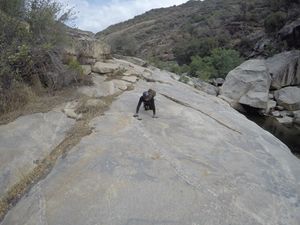Incidents:Fractured Foot in Lower Jump
| Fractured Foot in Lower Jump | |
|---|---|
| Date | 2015/07/13 |
| Location | Jump Trip (Lower) |
| Severity | Injury |
| Canyoneering-related | Yes
|
| SAR involvement | No
|
| Navigation problem | No
|
| Swift water problem | |
| Environmental problem | No
|
| Communication problem | Yes
|
| Planning problem | No
|
| Skills problem | No
|
| Body movement problem | No
|
| Rigging problem | No
|
| Rappel problem | No
|
| Insufficient gear | No
|
| Gear failure | No
|
Summary[edit]
Jumped from a small waterfall (~4) onto a slightly submerged boulder. Boom, crack, grunt. Christian can no longer walk.
Accounts[edit]
This occurred immediately after what's labeled "Lateral Climb RDC" on the map for Lower Jump. After you climb on the right, you come to a small waterfall about ~4' that you can jump into a good size pool. Prime location to jump is from the left or right on watercourse. The right side has a boulder you would need to clear, jumping maybe 5' out will easily clear the boulder. Alternatively, one can down climb on the far right or hand line. SNC comes up to the fall, assesses, and tries to communicate with two canyoneers that had already negotiated the obstacle as to what they did. All options were considered, but perhaps in a lapse judgement, SNC decides to jump on the right side. Given the boulder present, instead of jumping to clear it, the idea was to pull some kind of precision Jackie Chan jump between the rock SNC was standing on and the boulder in front of him. This was a gap of about 18" that got wider to the sides. Well, SNC did not clear it entirely. The left foot was just too far forward, high fiving the boulder. An instant shock passed through SNC's entire body and a crack was felt on the front area on the foot.
At first nothing seemed amiss, just the initial shock/pain from impact. The pool was a swimmer so there was no need to stand. As the pool got shallower, SNC started to feel the pain on the left foot again as it grazed the sandy bottom but it wasn't until he had to stand that he realized he wasn't able to. He could not bear ANY weight on the foot. In a panic, he removed his Water Tennies and neoprene sock to inspect, but nothing looked out of the ordinary. No bone sticking out, no deformation, no swelling, and even no pain when poking at it. Pain was excruciatingly exclusive when bearing weight on the foot. From this point, there is about another mile of hiking. Hiking SNC could not do. So with a combination of rolling around, crawling on all fours, piggy back rides, and funky partner assists, the group made its way through the Toboggan area, the large waterfall that was bypassed LDC, the final slog section, the last jump, and the powerhouse bypass trail.
When SNC made it out of the water, the foot was still unchanged. Nothing visual or swelling. It wasn't until the arrival at camp, Kirch Flat Campground, that the foot had ballooned. Pain kicked in and consumption of alcohol began. SNC decided to wait until the next morning and see how it progressed. Despite the foot being elevated all night and submerged in icy water pretty much the entire time, the swelling got a little worse and pain was still persistent. Only then did the group part ways so SNC could pay a visit to the ER. Initial assessment per the Xrays was that nothing was broken, just a really bad sprain. Months later, per SNC's insistence, a CT scan was made and it was revealed that there were in fact fractures, and some fragments. Official report:
Subacute Lisfranc fracture subluxation with osseous fragments in the expected course of the Lisfranc ligament. Additional tiny chip fracture of the third metatarsal base. Resulting mild lateral subluxation of the second and third metatarsals with respect to the tarsals. Subacute fourth metatarsal base intra-articular fracture with bony bridging.
It was later learned that the reason why the fractures didn't show up on the first xray was due to being an occult fracture. Not large enough to show up on xray initially, but once it healed and the cartilaginous base started to form, it spread the pieces apart and thus showing on the scan later.
